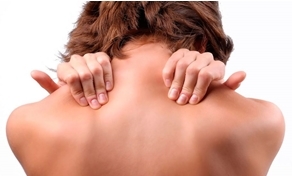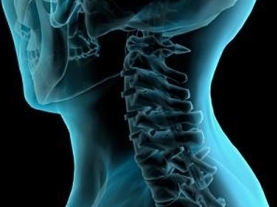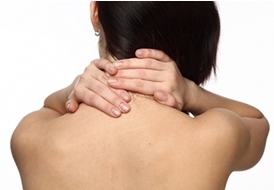
Osteochondrosis is a disease of the musculoskeletal system. According to statistics, about 90% of the population suffers from this. Most patients are not even aware of this, as the initial forms of the disease develop asymptomatically.
Another part of the people only periodically experience discomfort in the back area, write it off as fatigue and are not treated. Among all types of osteochondrosis, the lesion of the cervical vertebrae predominates. If treatment is started on time, there is every chance that you will get rid of the disease.
The essence of osteochondrosis
Two mechanisms are involved in the development of osteochondrosis: dystrophic and degenerative. The first suggests a violation of trophism (nutrition) of the intervertebral cartilage (discs). The second is a consequence of dystrophy - organic changes in the structure of cartilage and vertebrae.
The essence of the disease is as follows: circulatory disorders in certain areas of the back lead to depletion and dehydration of cartilage tissue. Along with the fluid, it loses its nutrients. As a result, the cartilage loses its elasticity and hardness - it sags. The distance between the vertebrae decreases, their staticity is disturbed (constancy of position). They can move and nest against each other while pinching the nerve roots.
In osteochondrosis, cartilage wears out at an accelerated rate.
If the dystrophy continues, the muscles that support the spine also lose tone. The vertebrae sag even more. Due to the increased friction, protrusions develop - damage to the cartilage capsule with protrusion of its contents outwards.
Then the natural defense mechanism of the spine is activated. Bone growths - osteophytes appear on it. They must ensure a stable position of the vertebrae. However, the growth of osteophytes often exceeds the "need". Too large growths put additional pressure on the remnants of cartilage, nerve fibers. Besides, they are solid. The spine loses its elasticity, "adjacent discs" can be damaged. The patient loses mobility, suffers from severe pain. The result of advanced osteochondrosis is damage.
Due to blood congestion, osteochondrosis is accompanied by the deposition of salts in areas adjacent to cartilage. Such "accumulations" worsen the development of the disease, accelerating the damage to cartilage and vertebrae.
Why the neck hurts more often
The cervical spine is the most sensitive and fragile. Its elements are the smallest and are not suitable for heavy loads. However, the neck muscles are not involved in all types of physical activity. Therefore, chronic congestion and malnutrition of the spinal joints. If a person does not exercise, the risk of cervical osteochondrosis increases significantly. Most people very rarely use their neck for daily tasks.
The main cause of osteochondrosis is a hypodynamic lifestyle. Lack of exercise, combined with passive rest, leads to muscle weakness and vascular tone disorders. Neck disease provokes prolonged stay in one position. Osteochondrosis of the cervical spine is considered by many office workers and computer scientists.
Excessive physical activity leads to muscular hypertension. Constantly in a tense state, they also provoke stagnant processes. Indirect causes of the disease include poor nutrition (excess salts and fats in the diet), metabolic disorders. The disease can be caused by autoimmune processes, lack of nutrients (vitamins and minerals), endocrine diseases and psycho-emotional shocks (as they are also accompanied by muscle strain).
How to recognize cervical osteochondrosis

Early osteochondrosis does not manifest itself in any way. At the 1st stage of development, the cartilage becomes dehydrated. Not noticeable from the outside, does not cause physical discomfort. The disease can be detected accidentally, when examining the spine for injuries or other complaints.
In stage 2, the cartilage sags. Its height decreases, the depreciation capacity deteriorates. Early symptoms may appear at this stage. Their characteristic is periodicity. The discomfort in the neck is clearly felt, after which it subsides. Periodically disappears completely. One sometimes experiences neck pain. They appear after exercise or a long stay in one position (sitting or standing). Unpleasant sensations appear in the morning as the patient "walks", loses weight and reminds himself in the late afternoon. If salts are deposited in the cervical region, a person hears a crunch in the spine when turning. "Clicking" when tilting the head does not hurt.
In stage 3, the nerve roots may be partially trapped. This is accompanied by severe pain. Patients complain of lumbago and sharp sudden neck pain. Discomfort occurs after a static position. Unlike the early stages, he worries more often. A person's neck "gets tired" in a short time. There may also be aches and pains. They attack the patient in the evening and at night.
Stagnation in the cervical spine leads to a cerebrovascular accident. Manifested by headache (sometimes migraine), tinnitus, dizziness. With persistent hypoxia (lack of oxygen) there is a feeling of "goosebumps" on the scalp, often on one side. There are also secondary symptoms - the patient gets tired quickly, feels weak, sleepy (for no apparent reason), sometimes sleep is disturbed.
Along with the listed symptoms, the mobility of the joints in the cervical vertebrae changes. Some movements of the head or neck are accompanied by sharp pain. The patient subconsciously reduces his amplitude, trying to maintain a comfortable position.
Stage 4 of osteochondrosis is accompanied by bulges and the appearance of osteophytes. Nerve root disorder leading to persistent pain syndrome. If the inflammation develops in the process of change, the pain becomes permanent. A person has more and more headaches, visual impairments (deterioration of vision at dusk, "flies", blurred picture). The mobility of the neck is significantly limited. The patient avoids turning the neck, if necessary, turns the whole body. When nerves are damaged, there is pain, tingling or tingling in the shoulders, shoulders, forearms and even the arms.
Diagnostics

The above complaints should be addressed to a neurologist, orthopedist or vertebrologist. The doctor will interview the patient, perform an examination. During the examination he will check the sensitivity of the points, the reflexes, the mobility of the cervical vertebrae. If osteochondrosis is suspected, an additional examination will be prescribed. It includes an X-ray of the cervical spine in several projections.
If there are no specific X-ray abnormalities, but the patient still has complaints, an MRI or CT scan is prescribed. With these methods, osteochondrosis can be detected even in the earliest stages.
How to treat yourself
Even if the patient has all the signs of osteochondrosis, it is better to see a doctor. Only a specialist can objectively assess the extent of destruction, distinguish chondrosis from other diseases, make the correct diagnosis and individually choose a treatment regimen.
The development of this disease takes a long time. Exacerbations of osteochondrosis can occur periodically and disappear on their own. The patient still needs to be examined.
The disease is treated on an outpatient basis. Surgery (to remove osteophytes) is a last resort, which is used only for serious damage to the nerve roots with severe pain. Conservative treatment can almost always be refused.
Osteochondrosis (depending on the stage) is treated for 1 to 3 months. Therapy should be comprehensive. Only medicines are indispensable here. Even after the onset of improvement, the patient must monitor their activities and take preventive measures. The main task of treatment is to stop the degenerative processes. Relieving the symptoms with medication only relieves the patient's condition for a while. There are several ways to treat osteochondrosis at home.
Drug therapy
With the help of drugs you can eliminate inflammation, relieve pain, provide the body with nutrients and improve the nutrition of the cartilage of the cervical spine. Pain relievers are used as a symptomatic treatment. In the inflammatory process, the pain is eliminated with the help of NSAIDs. The drugs are prescribed in the form of tablets (if the symptoms are moderate) or injections (if the pain is severe).
To eliminate muscle hypertension, muscle relaxants are prescribed in parallel with NSAIDs. These drugs improve the effect of painkillers, providing them with "free access" to the focus of inflammation. Pain medications are used in the shortest possible course (5-10 days) due to the risk of side effects.
Chondroprotectors are prescribed to increase elasticity and restore cartilage. In the acute period, these are injections. As maintenance therapy, doctors recommend long-term use (3-6 months) of capsules or tablets.
To increase the effectiveness of treatment, taking pills can be combined with the use of external means (ointments, gels, patches). Pepper or menthol patches that relieve pain ointments will relieve severe pain. In addition, osteochondrosis can be treated with chondroprotective ointments.
B vitamins and vascular preparations are prescribed to improve joint trophism.
Folk remedies

In the recipes of traditional medicine there are many recommendations for the treatment of osteochondrosis. As with the traditional approach, folk remedies can be used internally or externally.
The most powerful current mixes:
- Horseradish compress.Horseradish root is rubbed on a fine grater, spread the paste on gauze, applied to the neck, covered with a film, wrapped in a bandage, left for 2 hours, washed with clean water, the procedure is carried out for 10 daysin a row before bedtime.
- Compress with potatoes.Grate 3 large potatoes, add 1 tablespoon of honey and 1 tablespoon of mustard, spread the mixture on cheesecloth and attach to the sore spot for 1 hour, apply a compress 2 times a day for 2 weeks.
- Lotions with paprika.2 pods of cayenne pepper are crushed into a pulp, mixed with chopped aloe leaf, poured a glass of alcohol, a day later the gauze is moistened in the mixture, applied to the neck for 15-20 minutes, washed withlukewarm water. The treatment lasts 2 weeks.
Mustard and black pepper compresses are good for increasing blood circulation.
Inside you can take infusions, decoctions and tinctures. All recipes are aimed at normalizing metabolism, eliminating salts, eliminating inflammation:
- Parsley broth.3 tablespoons parsley seeds grind in a coffee grinder. Pour the mass with a liter of boiling water, simmer on low heat for 10-15 minutes. After complete cooling, filter. Take 100 ml orally twice daily for 15 days.
- Barberry tincture.10 g of a mixture of dried roots and barberry bark (available at the pharmacy or herbalists) is poured with 100 ml of alcohol or vodka. The mixture is placed in a dark place for 10 days. After straining, take 30 drops orally three times a day half an hour before meals.
- Celery infusion.Pour a tablespoon of grated celery root with a liter of water. Bring to a boil over low heat, turn off immediately. After one day, filter, take 3 tablespoons before meals three times a day. The treatment lasts 1 month.
Before using any traditional medicines, you must make sure that you are not allergic to their components. If a strong burning sensation occurs when using compresses, you should remove the bandage and rinse the remaining mixture under running water.
Physiotherapy, exercises and massage

Physiotherapy is often prescribed by doctors to treat osteochondrosis. This can be heating with medical ultraviolet light, exposure to low frequency currents, magnetic therapy, electrophoresis or phonophoresis. Such manipulations are performed in a hospital using special equipment. They eliminate inflammation and improve the access of drugs to the cartilage tissue. The combination of medication and physical therapy can quickly relieve the unpleasant symptoms. The course will require 10-15 procedures. To get a stable result, all types of physiotherapy must be completed completely (do not interrupt).
Physical therapy for the treatment of osteochondrosis of the neck includes simple exercises. They can be performed independently in the morning and evening, as well as between work. Physical education can be done while sitting or standing.
The following exercises can be included in the exercise for cervical osteochondrosis:
- Turn your head clockwise for 2 minutes first, then counterclockwise (2 sets)
- gently lower your head forward, backward and sideways (15 times in each direction);
- raise your shoulders as high as possible, leaving your neck and head still (15-20 times);
- turn your shoulders forward or backward, keeping your neck and head still (1 minute in each direction);
- fold your palms, pressing your fingertips in the center of the forehead, gently lead through the temporal areas, along the neck, to the collarbone (10 times);
- without changing the position of the chin, gently pull the neck back (chin is inhaled), then forward, to the sides (without tilting or turning the face);
- gather your palms in the lock behind your back, pull your arms back, lifting and stretching your neck as high as possible, stay in an extended position for 15 seconds (3 times).
In osteochondrosis, massage is considered the best way to improve blood circulation in the neck. It is better for the patient to take a full course (10-15 sessions) with a trained specialist. If this is not possible, you can knead your own door at home.
Quick self-massage guide:
- the neck muscles must first be warmed up: rub the back of the head with the pads of the fingers or the edge of the palm;
- kneading includes soft pressing, followed by muscle relaxation - kneading with 4 collected pads and thumb;
- gently pinch the skin of the neck to improve blood circulation;
- by light pressure with a finger on both sides of the spine, passes over the entire cervical region;
- To relax the nape of the neck, tap lightly with your palm or fingers.
Each stage of the massage ends with a light tap of the palm. To improve the effect, the neck is massaged with ointment. After the massage you should make sure that the cervical area is warm.
Massage your neck only with your palms or fingertips (not your fist).

All methods of treating osteochondrosis should be supplemented with diet. The classic healthy diet includes the use of lean meat, fish, seafood, whole grains and lots of vegetables. Food should be boiled, baked or steamed.
For the entire period of the diet it is necessary to reduce the amount of salt consumed, to give up fast food and sweets. It is important to drink at least 1. 5 liters of water a day. It is useful to eat jellies and jellies to strengthen joints.
With an integrated approach, the symptoms of the disease will disappear after a week and the destruction of cartilage will be completely stopped.



































